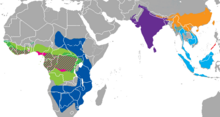Smutsia
| Smutsia | |
|---|---|

| |
| Pangolins from genusSmutsia | |
| Scientific classification | |
| Domain: | Eukaryota |
| Kingdom: | Animalia |
| Phylum: | Chordata |
| Class: | Mammalia |
| Order: | Pholidota |
| Family: | Manidae |
| Subfamily: | Smutsiinae Gray, 1873[3] |
| Genus: | Smutsia Gray,1865[2] |
| Type species | |
| Smutsia gigantea Illiger, 1815
| |
| Species | |
| |

| |
| Synonyms | |
|
synonyms of subfamily:
| |
African ground pangolin(Smutsia- "Smuts'sanimal ") is a genus ofpangolinsfrom subfamilySmutsiinaewithin familyManidae.It was formerly considered a subgenus of genusManis.[4]Its members are the moreterrestrialof theAfricanpangolins.[5]In past, this genus was also present inEurope.[6]
Description
The Smutsia species can be easily distinguished due to the layer of protective horny scales. They have a long streamlined body, its small coned shaped head, and thick tails that are covered with overlapping scales that resemble artichoke leaves. The color of these scales are between a yellow and brown color and are composed of fused hairs. These scales are often important to this species, when it feels threatened, they will roll itself into an impenetrable ball and the sharp scales are left exposed to the predator.
Diet and nutrition
The ground pangolins are carnivorous animals that only eat termites and ants and oftentimes will also eat larvae and other soft-bodied insects.
Mating life
Ground pangolins are described aspolygynousanimals which means when one malemateswith multiple females but females can only mate with a single male. During the mating process, gestation may occur for 139 days until one young is born. The setting in which this occurs is an underground shelter until the babies reach 2 to 4 weeks then they are carried outside. The baby will stay with its mother until it reaches 3 months of birth. Pups are able to start the breeding process until they are 5–7 years old.
Etymology
[edit]BritishnaturalistJohn Edward GraynamedSmutsiaforSouth AfricannaturalistJohannes Smuts(1808–1869),[7][8]the first South African to write atreatiseon mammals in 1832 (in which he described the speciesManis temminckii).
Taxonomy
[edit]- Subfamily:Smutsiinae(Gray, 1873)(large African pangolins)
- Genus:Smutsia(Gray, 1865)(African ground pangolin)
- Smutsia gigantea(Illiger, 1815)(giant pangolin)
- Smutsia temminckii(Smuts, 1832)(ground pangolin)
- †Smutsia olteniensis(Terhune, 2021)[9]
- Genus:Smutsia(Gray, 1865)(African ground pangolin)
Phylogeny
[edit]Phylogenetic position of genusSmutsiawithin family Manidae[10][11][12][1]
| Pholidotamorpha |
| |||||||||||||||||||||
(Pholidotasensu lato)
|
See also
[edit]References
[edit]- ^abSean P. Heighton, Rémi Allio, Jérôme Murienne, Jordi Salmona, Hao Meng, Céline Scornavacca, Armanda D. S. Bastos, Flobert Njiokou, Darren W. Pietersen, Marie-Ka Tilak, Shu-Jin Luo, Frédéric Delsuc, Philippe Gaubert (2023.)"Pangolin genomes offer key insights and resources for the world’s most trafficked wild mammals"
- ^Gray, J. E. (1865)."Revision of the genera and species of entomophagous edentata, founded on the examination of the specimens in the British Museum".Proceedings of the Zoological Society:359–386.
- ^Gray, J. E. (1873)."Hand-list of the edentate, thick-skinned and ruminant mammals in the British Museum".London, Printed by order of the Trustees: 1–176.
{{cite journal}}:Cite journal requires|journal=(help) - ^Schlitter, D.A. (2005)."Order Pholidota".InWilson, D.E.;Reeder, D.M (eds.).Mammal Species of the World: A Taxonomic and Geographic Reference(3rd ed.). Johns Hopkins University Press. pp. 530–531.ISBN978-0-8018-8221-0.OCLC62265494.
- ^du Toit, Z.; du Plessis, M.; Dalton, D. L.; Jansen, R.; Paul Grobler, J.; Kotzé, A. (2017)."Mitochondrial genomes of African pangolins and insights into evolutionary patterns and phylogeny of the family Manidae".BMC Genomics.18(1): 746.doi:10.1186/s12864-017-4140-5.PMC5609056.PMID28934931.
- ^"Two-Million-Year-Old Pangolin Fossil Found in Romania | Sci.News".12 January 2022.
- ^"S2A3 Biographical Database of Southern African Science [Johannes Smuts]".RetrievedMay 28,2018.
- ^Palmer, T.S. (1904)."Index Generum Mammalium: a List of the Genera and Families of Mammals".North American Fauna.23:635.doi:10.3996/nafa.23.0001.
- ^Terhune, C. E.; Gaudin, T.; Curran, S.; Petculescu, A. (2021). "The youngest pangolin (Mammalia, Pholidota) from Europe".Journal of Vertebrate Paleontology.41(4): e1990075.Bibcode:2021JVPal..41E0075T.doi:10.1080/02724634.2021.1990075.S2CID245394367.
- ^Gaudin, Timothy (2009)."The Phylogeny of Living and Extinct Pangolins (Mammalia, Pholidota) and Associated Taxa: A Morphology Based Analysis"(PDF).Journal of Mammalian Evolution.16(4). Heidelberg, Germany: Springer Science+Business Media: 235–305.doi:10.1007/s10914-009-9119-9.S2CID1773698.Archived fromthe original(PDF)on 2015-09-25.Retrieved2020-12-20.
- ^Kondrashov, Peter; Agadjanian, Alexandre K. (2012). "A nearly complete skeleton ofErnanodon(Mammalia, Palaeanodonta) from Mongolia: morphofunctional analysis ".Journal of Vertebrate Paleontology.32(5): 983–1001.Bibcode:2012JVPal..32..983K.doi:10.1080/02724634.2012.694319.ISSN0272-4634.S2CID86059673.
- ^Philippe Gaubert, Agostinho Antunes, Hao Meng, Lin Miao, Stéphane Peigné, Fabienne Justy, Flobert Njiokou, Sylvain Dufour, Emmanuel Danquah, Jayanthi Alahakoon, Erik Verheyen, William T Stanley, Stephen J O’Brien, Warren E Johnson, Shu-Jin Luo (2018)"The Complete Phylogeny of Pangolins: Scaling Up Resources for the Molecular Tracing of the Most Trafficked Mammals on Earth"Journal of Heredity, Volume 109, Issue 4, Pages 347–359
- ^"Smutsia temminckii Ground Pangolin (Temminck's Ground Pangolin, Cape Pangolin): Fr. Pangolin terrestre du Cap; Ger. Steppenschuppentier",Mammals of Africa: Carnivores, Pangolins, Equids and Rhinoceroses,Bloomsbury Publishing, 2013,doi:10.5040/9781472926951.0093,ISBN978-1-4729-2695-1,retrieved2023-10-28
